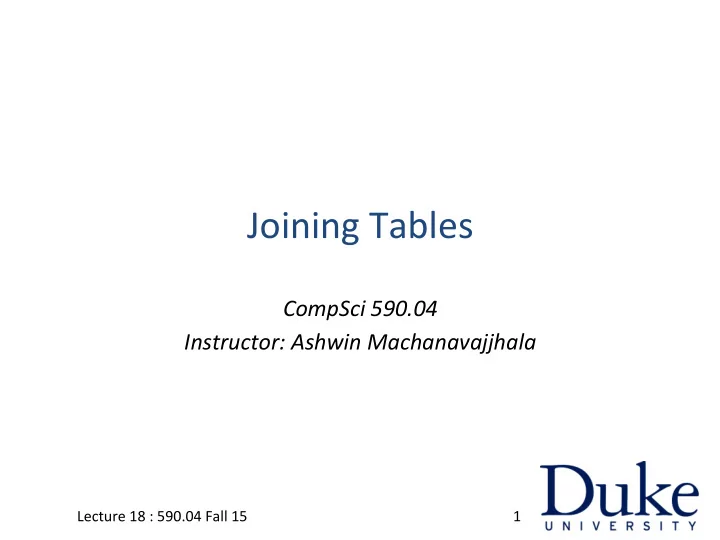

Joining ¡Tables ¡ CompSci ¡590.04 ¡ Instructor: ¡Ashwin ¡Machanavajjhala ¡ ¡ Lecture ¡18 ¡: ¡590.04 ¡Fall ¡15 ¡ 1 ¡
A ¡SQL ¡Query ¡walks ¡into ¡a ¡bar. ¡In ¡the ¡corner ¡of ¡the ¡bar ¡are ¡two ¡ tables. ¡The ¡Query ¡walks ¡up ¡to ¡the ¡tables ¡and ¡asks, ¡ “Mind ¡if ¡I ¡join ¡you?” ¡ 2 ¡ Image ¡credit: ¡ http://www.swcasinoproductions.com/images/party-rentals/lighted-tables-buffets-furniture/party-rentals-lighted-bar-acrylic.jpg
Why ¡Joins? ¡ • Cornerstone ¡of ¡the ¡relaEon ¡data ¡model! ¡ • NormalizaEon ¡of ¡schema ¡helps ¡reduce ¡redundancy ¡and ¡ inconsistencies. ¡ ¡ – Social ¡network: ¡Table ¡of ¡edges ¡and ¡Table ¡of ¡verEces ¡ • To ¡reason ¡about ¡relaEonships ¡between ¡mulEple ¡types ¡of ¡enEEes ¡ – How ¡many ¡triangles ¡are ¡there ¡in ¡a ¡graph ¡ • To ¡answer ¡queries ¡over ¡data ¡split ¡over ¡mulEple ¡tables ¡ – Need ¡to ¡join ¡a ¡table ¡of ¡income ¡and ¡table ¡of ¡educaEon ¡to ¡get ¡correlaEon ¡ between ¡the ¡two ¡aQributes. ¡ ¡ Lecture ¡18 ¡: ¡590.04 ¡Fall ¡15 ¡ 3 ¡
A ¡short ¡detour ¡through ¡datalog ¡ • Suppose ¡we ¡have ¡a ¡relaEonal ¡schema ¡R(A, ¡B) ¡and ¡S(B, ¡C). ¡ ¡ – R ¡is ¡a ¡table ¡with ¡two ¡aQributes ¡A ¡and ¡B ¡ – S ¡is ¡a ¡table ¡with ¡two ¡aQributes ¡B ¡and ¡C ¡ • Natural ¡join: ¡Join ¡every ¡row ¡in ¡R ¡with ¡every ¡row ¡in ¡S ¡whenever ¡ they ¡agree ¡on ¡the ¡B ¡aQribute. ¡ ¡ ¡J(a, ¡b, ¡c) ¡:-‑ ¡ ¡R(a,b) ¡ ∧ S(b, ¡c) ¡ • Triangle ¡counEng: ¡ ¡ ¡T(a, ¡b, ¡c) ¡:-‑ ¡E(a,b) ¡E(b,c) ¡E(c,d) ¡ ¡ • We ¡can ¡express ¡most ¡SQL ¡queries ¡in ¡datalog ¡ ¡Z(a,c) ¡:-‑ ¡R(a, ¡b) ¡ ∧ ! S(b, ¡c) ¡ ∧ ! b=‘b’ ¡ Lecture ¡18 ¡: ¡590.04 ¡Fall ¡15 ¡ 4 ¡
QuesEon: ¡What ¡is ¡the ¡best ¡method ¡for ¡ compuEng ¡a ¡join ¡ ¡ ¡ ¡ ¡ ¡ ¡J(a,b,c) ¡:-‑ ¡R(a,b), ¡S(b,c) ¡ ¡ ¡ Lecture ¡18 ¡: ¡590.04 ¡Fall ¡15 ¡ 5 ¡
QuesEon: ¡What ¡is ¡the ¡best ¡method ¡for ¡ compuEng ¡a ¡join ¡ ¡ ¡ ¡ ¡ ¡ ¡J(a,b,c) ¡:-‑ ¡R(a,b), ¡S(b,c) ¡ ¡ ¡ Many ¡techniques ¡are ¡known ¡(this ¡is ¡a ¡40 ¡year ¡old ¡problem)! ¡ • X ¡-‑ ¡Nested ¡Loop ¡Join ¡(X ¡= ¡“”, ¡Block, ¡Index, ¡…) ¡ • Hash ¡Join ¡ • Sort ¡Merge ¡Join ¡ • … ¡ ¡ ¡ Lecture ¡18 ¡: ¡590.04 ¡Fall ¡15 ¡ 6 ¡
Joining ¡2 ¡tables ¡in ¡parallel ¡systems ¡ Hash ¡Join: ¡ • Hash ¡records ¡to ¡reducers ¡ ¡ • Join ¡in ¡the ¡reducer. ¡ ¡ ¡ Fragment ¡Replicated ¡Join : ¡ ¡ • When ¡one ¡of ¡the ¡tables ¡is ¡small ¡enough ¡to ¡fit ¡in ¡memory. ¡ • Replicate ¡the ¡“small” ¡table ¡to ¡all ¡mappers ¡containing ¡the ¡other ¡ “large” ¡table. ¡ ¡ Merge ¡Join: ¡ ¡ • When ¡two ¡datasets ¡are ¡already ¡sorted ¡on ¡the ¡join ¡key ¡ ¡ • Use ¡sort ¡merge ¡join. ¡ ¡ ¡ Lecture ¡18 ¡: ¡590.04 ¡Fall ¡15 ¡ 7 ¡
Join ¡as ¡an ¡opEmizaEon ¡problem ¡ • ObjecEve: ¡minimize ¡job ¡compleEon ¡Eme ¡ ¡ • Cost ¡at ¡a ¡reducer: ¡ ¡ t$at$a$reducer:$$ ¡ • Input-‑size ¡dominated: ¡Reducer ¡input ¡processing ¡Eme ¡is ¡large ¡ ¡ ut<size$dominated:$Reducer$input$processing$Ame$is$large • Output-‑size ¡dominated: ¡Reducer ¡output ¡processing ¡Eme ¡is ¡large ¡ ¡ Lecture ¡18 ¡: ¡590.04 ¡Fall ¡15 ¡ 8 ¡
Join ¡Matrix ¡ M ij $is$shaded$if$corresponding$tuples$appear$in$the$join$output.$$ Goal:$find$a$mapping$between$join$matrix$cells$to$reducers$that$$ Goal:$find$a$mapping$between$join$matrix$cells$to$reducers$that$$ $$$$$$$$$$$minimizes$compleQon$Qme.$$ Lecture ¡18 ¡: ¡590.04 ¡Fall ¡15 ¡ 9 ¡
Join ¡AlternaEves ¡ Join • Standard ¡join ¡algorithm ¡ • • Group ¡both ¡tables ¡by ¡the ¡key, ¡send ¡all ¡ • tuples ¡with ¡same ¡key ¡to ¡a ¡single ¡ reducer ¡ • • Skew ¡in ¡7 ¡leads ¡to ¡long ¡compleEon ¡ Eme. ¡ ¡ Lecture$12$:$590.02$Spring$13$ Lecture ¡18 ¡: ¡590.04 ¡Fall ¡15 ¡ 10 ¡
Join ¡AlternaEves ¡ Joi • Fine ¡grained ¡load ¡balancing. ¡ – Divide ¡the ¡cells ¡in ¡the ¡join ¡matrix ¡equally ¡ amongst ¡reducers ¡ • Leads ¡to ¡replicaEon ¡of ¡tuples ¡to ¡mulEple ¡ reducers ¡ ¡ – Higher ¡communicaEon ¡cost ¡ Lecture$12$:$590.02$Spring$13 Lecture ¡18 ¡: ¡590.04 ¡Fall ¡15 ¡ 11 ¡
Join ¡AlternaEves ¡ Join • Best ¡of ¡both ¡worlds ¡ • • Key ¡7 ¡is ¡broken ¡into ¡two ¡different ¡ • reducers ¡ • • Limits ¡replicaEon ¡of ¡input ¡as ¡well ¡as ¡ reduces ¡skew ¡ Lecture ¡18 ¡: ¡590.04 ¡Fall ¡15 ¡ 12 ¡ Lecture$12$:$590.02$Spring$13$
General ¡Strategy ¡ • IdenEfy ¡the ¡regions ¡in ¡the ¡join ¡matrix ¡that ¡appear ¡in ¡the ¡join ¡ – Sufficient ¡to ¡idenEfy ¡a ¡superset ¡of ¡the ¡shaded ¡cells ¡in ¡the ¡join ¡matrix ¡ • Map ¡regions ¡of ¡the ¡join ¡matrix ¡to ¡reducers ¡such ¡that ¡each ¡shaded ¡ cell ¡is ¡covered ¡by ¡a ¡reducer. ¡ ¡ Lecture ¡18 ¡: ¡590.04 ¡Fall ¡15 ¡ 13 ¡
MulE-‑way ¡Joins ¡ ¡ ¡ ¡J(a,b,c) ¡:-‑ ¡R(a,b) ¡S(b,c) ¡T(a,c) ¡ ¡ ¡ ¡ ¡//This ¡is ¡triangle ¡counIng ¡ ¡ ¡// ¡Suppose ¡each ¡table ¡has ¡the ¡same ¡size ¡N ¡ ¡ ¡ Lecture ¡18 ¡: ¡590.04 ¡Fall ¡15 ¡ 14 ¡
� � � � � MulE-‑way ¡Joins ¡ ¡ ¡ ¡J(a,b,c) ¡:-‑ ¡R(a,b) ¡S(b,c) ¡T(a,c) ¡ ¡ • Historically ¡databases ¡designers ¡decided ¡that ¡the ¡best ¡way ¡to ¡ handle ¡mulE-‑way ¡joins ¡is ¡to ¡do ¡them ¡one ¡pair ¡at ¡a ¡Eme. ¡ ¡ – For ¡efficiency ¡reasons. ¡ ¡ R2 R4 R3 R1 R3 R1 R2 R4 Left-deep plan Bushy plan � � � � � � Lecture ¡18 ¡: ¡590.04 ¡Fall ¡15 ¡ 15 ¡
Recommend
More recommend